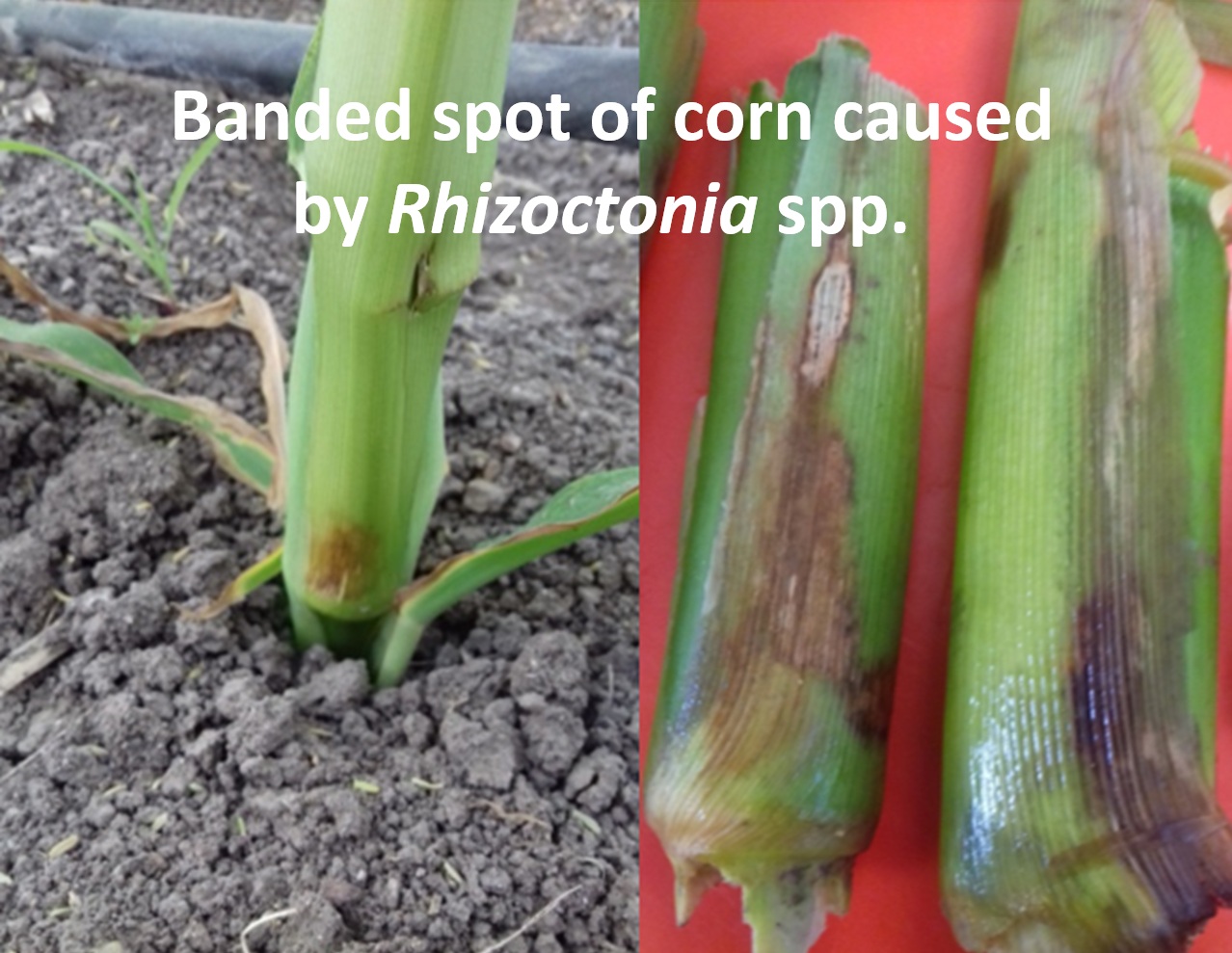Morphological, molecular and pathogenic characterization of Rhizoctonia isolates causing a banded spot of corn sheath in northern Sinaloa
DOI:
https://doi.org/10.17268/sci.agropecu.2025.021Keywords:
anastomosis, RPB2, severity, sclerotia, evolutionary tree analysis, cladistic analysisAbstract
Corn production is affected by fungi of the genus Rhizoctonia. The objective of this study was to characterize, using morphology, DNA sequence analysis, and pathogenicity, Rhizoctonia isolates associated with corn with banded leaf spot symptoms in commercial fields in northern Sinaloa. Diseased plants were collected in the municipalities of Ahome, El Fuerte, and Guasave, obtaining 27 isolates. Morphological characterization on PDA showed colonies with whitish to brown mycelium, pigment release into the medium, and amorphous, red and brown sclerotia with a diameter < 1 mm, characteristics described for Rhizoctonia. For molecular characterization, genomic DNA was extracted, part of the RPB2 gene was amplified by PCR, and the amplified products were sequenced. Phylogenetic analysis confirmed the identification of 18 isolates as Rhizoctonia zeae and 9 isolates as Rhizoctonia solani. The R. solani isolates correspond to the anastomosis group (AG): AG-4. Three of them correspond to the anastomosis subgroup AG-4 HGI and the other 6 to the subgroup AG-4 HGIII. The pathogenicity and severity of the isolates were evaluated in corn plants 34 days after planting, revealing significant differences (p > 0.05). This study will allow the development of disease management strategies and future research into biological and chemical control of Rhizoctonia species.
References
Demirci, E., & Kordali, S. (1999). Rhizoctonia Species and Anastomosis Groups from Corn Kernels in Turkey. Plant desease, 83(3), 879. https://doi.org/10.1094/PDIS.1999.83.9.879C
Gutiérrez, S.A., Cundom, M. A., Barrera, V., & Gason, L. (2007). First record of Rhizoctonia zeae on corn in Argentina. Australasian Plant Disease Notes, 2, 137-138. https://doi.org/10.1071/DN07054
Kimura, M. (1983). The Neutral Theory of Molecular Evolution. Cambridge: Cambridge University Press.
Kronland, W. C., & Stangellini, M. E. (1988). Clean slide technique for the observation of anastomosis and nuclear condition of Rhizoctonia solani. Phytopatology, 78, 820-822. https://doi.org/10.1094/phyto-78-820
Li, H. R., Wu, B. C., & Yan S. Q. (1998). Aetiology of Rhizoctonia in sheath blight of maize in Sichuan. Plant Pathology, 47, 16–21. https://doi.org/10.1046/j.1365-3059.1998.00201.x
Little, T. M., & Hills, F. J. (1989). Métodos estadísticos para la investigación en la agricultura. Ed. trillas 2a edición. México, D. F. 125-143 pp.
Liu, Z. L., & Sinclair J. B. (1993). Differentiation of intraspecific groups within anastomosis group 1 of Rhizoctonia solani using ribosomal DNA internal transcribed spacer and isozyme comparisons. Canadian Journal of Plant Pathology, 15(4), 272-280. https://doi.org/10.1080/07060669309501923
McNab, A., & Castro, C. (2004). Enfermedades del maíz: una guía para su identificación en el campo. http://hdl.handle.net/10883/715
Minaya, E., & Reyes, E. (2017). Identificación y caracterización del agente causal de la pudrición de la raíz y tallo del maíz (Zea mays L.). Aporte Santiaguino, 9(1), 69-80. http://dx.doi.org/10.32911/as.2016.v9.n1.214
Montero, V., Guerrero, B. Z., Anaya, J. L., Martínez, T. O., Guevara, L., & González, M. M. (2013). Diversidad genética de aislados de Rhizoctonia solani (Kuhn) de Chile en México. Rev. Mex. Cienc. Agríc., 4(7), 1043-1054.
Muis, A., & Quimio, A. J. (2006). Biological control of banded leaf and sheath blight disease (Rhizoctonia solani kuhn) in corn with formulated Bacillus subtilis BR23. Indonesian Journal of Agricultural Science, 7(1), 1-7.
Murray, M. G., & Thompson, W. F. (1980). Rapid isolation of high molecular weight plant DNA. Nucleic Acids Research, 8(19),4321-4325. http://dx.doi.org/10.1093/nar/8.19.4321
Muzhinji, N., Truter, M., Woodhall, J. W., & Van der Waals, J. E. (2015). Anastomosis groups and pathogenicity of Rhizoctonia solani and binucleate Rhizoctonia from potatoes in South Africa. Plant Disease, 99(12), 1970-1802. https://doi.org/10.1094/PDIS-02-15-0236-RE
Ohkura, M., Abawi, G. S., Smart, C. D., & Hodge, K. T. (2009). Diversity and aggressivensess of Rhizoctonia solani and Rhizoctonia-like fungi of vegetables in New York. Plant Dis., 93, 615-624. https://doi.org/10.1094/pdis-93-6-0615
Ortega-Acosta, S. A., Palemón-Alberto, F., Terrones-Salgado, J., Molina-Gayosso, E., Romero-Ramírez, Y., Toribio-jimenez, J., Villar-Luna, E., Barcenas-Santana, D., Juarez-Lopez, P., Cruz-Lagunas, B., & Reyes-Garcia, G. (2021). First report of Rhizoctonia solani AG-4 HG-I causing fruit rot on tomato in Mexico. Plant. Dis., 106, 1531. https://doi.org/10.1094/PDIS-09-21-2005-PDN
Orus, A. (2025). Volumen de maíz producido en los Estados Unidos desde 2011 hasta 2023. Statista. http://es.statista.com/estadisticas/517323/produccion-de-maiz-en-los-ee-uu/
Porebski, S.; Bailey, L. G., & Baum, B. R. (1997). Modification of a CTAB DNA extraction protocol for plants containing high polysaccharide and polyphenol components. Plant Mol. Biol. Reporter, 15(1), 8-15. https://doi.org/10.1007/BF02772108
Rabago-Zavala, K., Valenzuela-Escoboza, B. E., Lizarraga-Sanchez, G. J. & Valenzuela-Escoboza, F. V (2024). Morphological, molecular and pathogenic caracterization of Rhizoctonia solani isolate associated whit been drying in Northern Sinaloa, Mexico. Agro Productividad, 17(11) supplement, 253-261. https://doi.org/10.32854/agrop.v17i11.3143
Reeb, V., Lutzoni, F., & Roux, C. (2004). Contribution of RPB2 to multilocus phylogenetic studies of the euascomycetes (Pezizomycotina, fungi) with special emphasis on the lichen forming Acarosporaceae and evolution of polyspory. Molecular Phylogenetics and Evolution, 32, 1036-1060. https://doi.org/10.1016/j.ympev.2004.04.012
Sagar, G. C., & Bhusal, K. (2019). Banded Leaf and Sheath Bight (BLSB) of maize, its introduction, losses and management. Journal of Soil Science and Plant Physiology, 1(2), 1-6.
SIAP. (2023). Portal de Servicio de Información Agroalimentaria y Pesca. www.siap.sagarpa.gob.mx
Singh, V., Kumar, S., Lal, M., & Hooda K. S (2014). Cultural and morphological variability among Rhizoctonia solani isolates from trans-gangetic plains of India. Research on Crops, 15(3), 644-650. http://dx.doi.org/10.5958/2348-7542.2014.01390.4
Singh, R., Murti S., Mehilalm, Tomer, A., & Prasad D. (2015). Virulence Diversity in Rhizoctonia Solani Causing Sheath Blight in Rice. J Plant Pathol Microb, 6, 296. https://doi.org/10.4172/2157-7471.1000296
Sneh, B. (1996). Anastomosis groups of multinucleate Rhizoctonia spp. In: Sneh B, Jabaji-Hare S, Neate S, Dijst G, eds. Rhizoctonia Species: Taxonomy, Molecular Biology, Ecology, Pathology and Disease Control. Dordrecht, the Netherlands: Kluwer Academic Publishers, 67–75.
Tamura, K., & Nei, M. (1993). Estimation of the number of nucleotide substitutions in the control region of mitochondrial DNA in humans and chimpanzees. Molecular Biology and Evolution, 10, 512-526. https://doi.org/10.1093/oxfordjournals.molbev.a040023
Telmadarrehei, T., Ghambury, M. A. T., Rahimian, H., Rezazadeh, A., & Javadi, M. A. (2011). Isolation and some pathologic properties of Rhizoctonia zeae from cultural soils of Golestan and Mazandarán provinces, Iran. World Applied Sciences Journal, 14(3), 374-377.
Yang, Y. G., Zhao, C., Guo, Z. J., & Wu, X. H. (2014). Anastomosis groups and pathogenicity of binucleate Rhizoctonia isolates associated with stem canker of patato in China. Journal of Plant Pathology, 139, 535-544. https://doi.org/10.1007/s10658-014-0409-6
Zadoks, J. C., & Schein, R. D. (1979). Epidemiology and plant disease management. Oxford University Press. 427 p.
Zhang, D. H., & Chen, Y. X. (1986). Anastomosis grouping of binucleate Rhizoctonia. Chinese Journal of Plant Pathology, 16, 139–144.

Published
How to Cite
Issue
Section
License
Copyright (c) 2025 Scientia Agropecuaria

This work is licensed under a Creative Commons Attribution-NonCommercial 4.0 International License.
The authors who publish in this journal accept the following conditions:
a. The authors retain the copyright and assign to the magazine the right of the first publication, with the work registered with the Creative Commons attribution license, which allows third parties to use the published information whenever they mention the authorship of the work and the First publication in this journal.
b. Authors may make other independent and additional contractual arrangements for non-exclusive distribution of the version of the article published in this journal (eg, include it in an institutional repository or publish it in a book) as long as it clearly indicates that the work Was first published in this journal.
c. Authors are encouraged to publish their work on the Internet (for example, on institutional or personal pages) before and during the review and publication process, as it can lead to productive exchanges and a greater and faster dissemination of work Published (see The Effect of Open Access).




